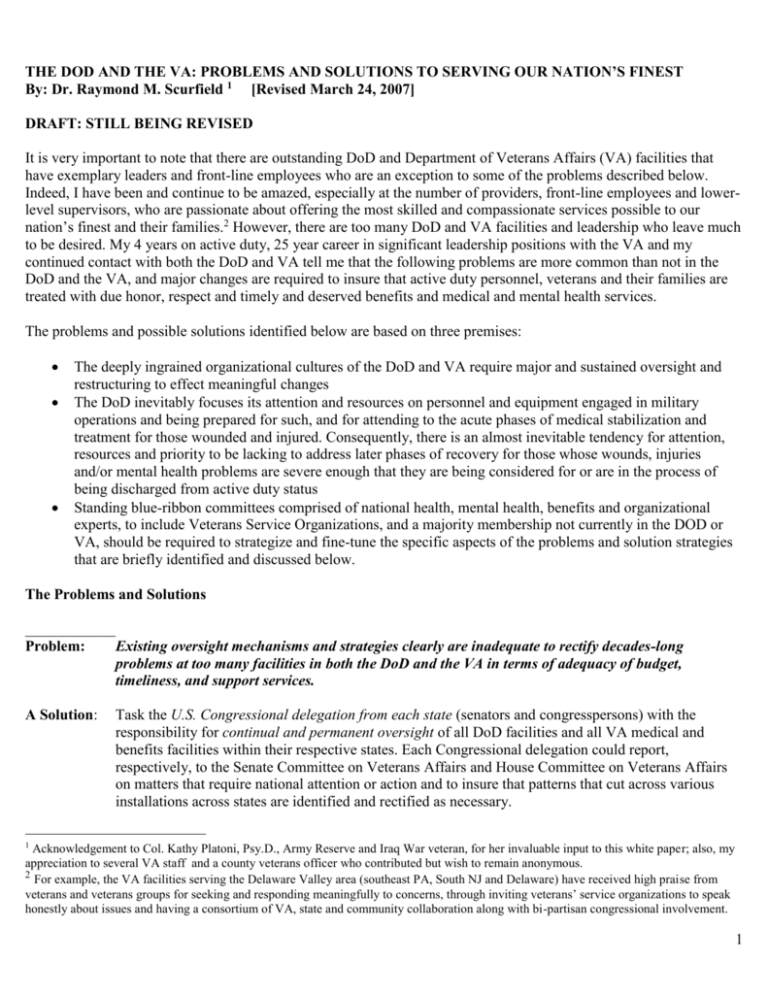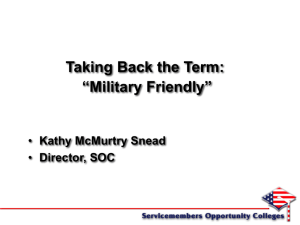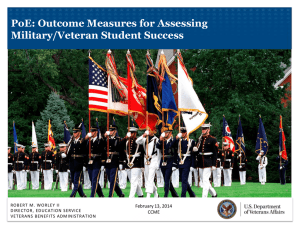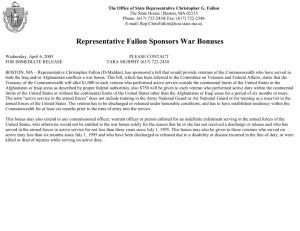THE DOD AND THE VA: PROBLEMS AND SOLUTIONS TO
advertisement

THE DOD AND THE VA: PROBLEMS AND SOLUTIONS TO SERVING OUR NATION’S FINEST By: Dr. Raymond M. Scurfield 1 [Revised March 24, 2007] DRAFT: STILL BEING REVISED It is very important to note that there are outstanding DoD and Department of Veterans Affairs (VA) facilities that have exemplary leaders and front-line employees who are an exception to some of the problems described below. Indeed, I have been and continue to be amazed, especially at the number of providers, front-line employees and lowerlevel supervisors, who are passionate about offering the most skilled and compassionate services possible to our nation’s finest and their families.2 However, there are too many DoD and VA facilities and leadership who leave much to be desired. My 4 years on active duty, 25 year career in significant leadership positions with the VA and my continued contact with both the DoD and VA tell me that the following problems are more common than not in the DoD and the VA, and major changes are required to insure that active duty personnel, veterans and their families are treated with due honor, respect and timely and deserved benefits and medical and mental health services. The problems and possible solutions identified below are based on three premises: The deeply ingrained organizational cultures of the DoD and VA require major and sustained oversight and restructuring to effect meaningful changes The DoD inevitably focuses its attention and resources on personnel and equipment engaged in military operations and being prepared for such, and for attending to the acute phases of medical stabilization and treatment for those wounded and injured. Consequently, there is an almost inevitable tendency for attention, resources and priority to be lacking to address later phases of recovery for those whose wounds, injuries and/or mental health problems are severe enough that they are being considered for or are in the process of being discharged from active duty status Standing blue-ribbon committees comprised of national health, mental health, benefits and organizational experts, to include Veterans Service Organizations, and a majority membership not currently in the DOD or VA, should be required to strategize and fine-tune the specific aspects of the problems and solution strategies that are briefly identified and discussed below. The Problems and Solutions ____________ Problem: Existing oversight mechanisms and strategies clearly are inadequate to rectify decades-long problems at too many facilities in both the DoD and the VA in terms of adequacy of budget, timeliness, and support services. A Solution: Task the U.S. Congressional delegation from each state (senators and congresspersons) with the responsibility for continual and permanent oversight of all DoD facilities and all VA medical and benefits facilities within their respective states. Each Congressional delegation could report, respectively, to the Senate Committee on Veterans Affairs and House Committee on Veterans Affairs on matters that require national attention or action and to insure that patterns that cut across various installations across states are identified and rectified as necessary. 1 Acknowledgement to Col. Kathy Platoni, Psy.D., Army Reserve and Iraq War veteran, for her invaluable input to this white paper; also, my appreciation to several VA staff and a county veterans officer who contributed but wish to remain anonymous. 2 For example, the VA facilities serving the Delaware Valley area (southeast PA, South NJ and Delaware) have received high praise from veterans and veterans groups for seeking and responding meaningfully to concerns, through inviting veterans’ service organizations to speak honestly about issues and having a consortium of VA, state and community collaboration along with bi-partisan congressional involvement. 1 The Congressional Delegation for each state could be assisted in their oversight responsibilities by veterans advisory councils or task forces (that involve consortiums described in the footnote below) to include at least one or two veterans from each of the last several major wars. This would include having a confidential and widely-accessible hot line available to ordinary citizens through which they could, with their identities protected, report problems and issues that may need investigated. In this way, oversight will be decentralized to national officials at the state level and will be much more accessible and responsive to all constituents, and how effectively the Congressional delegations fulfill their oversight function will be directly responsive to those who elected them to Congress. _____________ Problem: Too many DoD and VA officials and employees will not publicly or officially contradict anything that constitutes the official policies and positions of higher-ranking officials. Indeed, too often, “freedom of expression” by employees is not valued, encouraged or rewarded. For example, too many DoD and VA officials and front-line workers have known for years but have kept relatively silent about the budget not keeping up with current needs, yet alone being anywhere near adequate for expanding and projected new needs of active duty personnel, veterans and their families: Public expression of employees’ viewpoints and opinions is tightly controlled if not suppressed, censored and punished. Public Information Offices and Public Relations Offices tend to operate as censors to tightly control outsider access to employees who may or may not express the organization’s official policies and statements. The emphasis is on damage control so as to not bring embarrassment to higher-ranking officials and to the organization. Loyalty to the organization (e.g., conformity, acquiescence, and cost-containment) can reign paramount rather than positive reinforcement of employees speaking the truth, advocating for the rights of the customers and clients and going the extra step to serve clients. The organizations’ response to internal and external critics tends to be “you’re either with us or you are against us.” The strong tendency is to ignore obfuscate or attack the credibility of critics rather than straightforward admission that problems exist or that identified issues and allegations will be vigorously investigated. Because loyalty to the organization can reign paramount, there is a strong tendency to minimize, deny or suppress the admission or expression of any serious problems or issues in how the organization is adequately funded, operates or provides its services. Hence, censorship of meaningful written or verbal communications in public that might be construed as contrary to official pronouncements or policy is the rule. To the extent that Whistleblower legal protections are applicable, they should be applied. On the other hand, limitations in employment protections for Whistleblowers suggest that anonymity protection from the employer may be only meaningful form of protection that could promote truth telling about issues. A Solution: Allow and indeed encourage individual DoD officials throughout the chain of command, and VA Regional Office Directors and Hospital Directors and the key officials of various departments/sections (i.e. Veterans Service Officers, Chiefs of Staff, Chiefs of Service (i.e. Medicine, Surgery, Nursing, Psychology, Social Work, Mental Health), Vet Center Team Leaders, and individual staff, to have access to a communication system that allows them to confidentially provide information to their respective State Congressional delegation about issues and problems that they see at their facilities that they are concerned about and that need attention and/or action. This is especially needed when these local VA officials or employees have perceptions that are not congruent with those being articulated by higher-level VA officials. 2 ____________ Problem: “Customer service” or “consumer satisfaction” has not been institutionalized sufficiently through national policy and local implementation to drive the decisions or the practices of the DoD and the VA. This is demonstrated by several prevailing practices throughout the DoD and the VA: The DoD and the VA are monopolies that totally control deciding who receives what services and treatment, and their customers or clients essentially have no recourse to seek the same from other non-DoD or non-VA providers (without getting agency permission), e.g., the customers cannot “vote with their feet” and seek their services elsewhere without suffering a significant financial penalty. There too often is an “adversarial relationship” between the organizations and those seeking benefits, e.g., the predominant organizational attitude can be that the burden of proof is on the client to justify the amount of financial benefits to which he/she is applying for—rather than the burden of proof resting on the organizations to justify denial of such benefits. “Customer satisfaction” is not a system-wide meaningful element in all levels of performance evaluations---of line workers, supervisors, administrators or higher-level officials. Solution: There is a three-fold solution: 1. Implement “customer satisfaction” or “consumer satisfaction” as one of the primary objectives of the organization. Illustrative examples of how this might be actualized: Customer satisfaction, as determined by confidential surveys routinely administered to customers and by other verbal and written feedback from customers, would be instituted as a required and critical element by which the performances of all DoD and VA employees are evaluated. A culture of promoting customer satisfaction would be incorporated through intensive and repeated trainings and reinforcement in all aspects of the organizations, e.g., “the customer is always right” attitude and approach. A new system would be established to advertise, encourage and process customer issues and concerns and to promote the identification, evaluation, addressing of issues and giving timely feedback. Veterans Advisory Councils at each facility, to include some representatives of Veterans Service Organizations, Congressional representatives and other consumers of service, to work with providers and with command/administrative personnel to sensitize them to customer issues and feedback. The proceedings of such customer advisory boards would be publicized and widely circulated. Incorporate customer input (from both internal customers, i.e., line workers and lower-level supervisors) and external customers, i.e., those being provided services, perhaps through veterans advisory councils) into the review, interview and selection process for all key supervisory and administrative positions. 2. Revamp the disability and service-connection evaluation process to the benefit of the applicant, i.e., encourage applicants to have representation to help them in their application process with the organization; and possibly begin with “presumptive eligibility” of applicants and an initial approval of service-connection with full priority access to needed services, pending a more finalized decision later. 3. If the consumer satisfaction initiatives identified above are not sufficient to produce meaningful changes, evaluate the merits of instituting tandem positive and negative financial incentives to reinforce the priority of maximizing consumer satisfaction. Two illustrative examples to consider: Set aside a significant pool of funds at DoD and VA headquarters expressly for the purpose of being distributed to x facilities that have the highest customer satisfaction ratings in the system; 3 for example, to provide outstanding customer service awards and performance bonuses for outstanding customer service; and/or Allow up to a maximal agreed-upon percentage of service costs (say 20%) to be available in a voucher system for consumers to have the option to receive “vouchers” to be able to obtain such services from outside providers of their choice who would accept the DoD or VA payment schedule provided through the vouchers. Discussion: This set of initiatives has a ceiling on the monetary value of vouchers that could be issued in order to insure that a critical minimal amount of funding remains with the facility to allow for continued operations. Such a cap on vouchers is necessary because there are a number of political forces who would like nothing more than to dismantle the “non-military” functions of the DoD (such as medical) and the entire VA health care system and contract it out to private for-profit enterprise. This is particularly problematic if the Secretary of Veterans Affairs continues to be more responsive to current executive branch expectations than to the expectations of veterans and their families. Many military personnel and veterans prefer and are much more comfortable receiving services from those who are motivated to serve them in particular and who are very familiar with the DoD and veteran populations. Indeed, active duty and veteran populations constitute special needs that are over-represented and hence special expertise has been developed to address such conditions as traumatic amputees, traumatic brain injuries, post-traumatic stress, chronic pain and those living for decades with catastrophic injuries. If structured and operated properly, and with appropriate limits, a system that combined a pool of funds held back for distribution to those facilities highest-rated by customer and possibly coupled with a voucher system, would be strong inducements to motivate DoD and VA officials and employees to go out of their way to provide the best possible quality of service and strive to attain and maintain high consumer satisfaction. ___________ Problem: Active duty personnel in “medical hold” positions suffer from inattention and protracted “limbo” status in the gray area between active duty and becoming a veteran and linked into the VA system. This decades-long problem happens because there is an historic and continuing disconnect between the DoD and the VA systems, very inadequate familiarity of each system with the other, an internally-focused “turf” mentality within each and no effective institutionalized and sanctioned mission within both systems to focus on and effect anything approaching a seamless transition between leaving active duty status and entering the VA system. Solution: There must be clearly identified organizational elements within both the Dod and the VA that have the clear mission to focus on this transition and that are tasked to work with each other to insure a seamless transition. Within such an organizational arrangement, one implementation solution would be to establish hybrid positions (DoD/VA) who are combination transition coordinators and case managers whose primary responsibility is to track and be case managers for all active duty military personnel whose medical conditions are such that they are identified as no longer able to remain on active duty or able to remain on active duty, USAR, or USNG status with appropriate medical/mental health intervention. Such transition coordinators/case managers would oversee both the treatment, benefits and other outprocessing tasks and requirements in the final phases of leaving active duty status and their inprocessing to and actual connecting successfully with appropriate benefits and services of the VA system. Alternatively: upgrade all OEF/OIF coordinators in the VA to be full-time positions or have full-time DoD/VA transition coordinators/case manager positions embedded with Vet Centers. These positions would be sanctioned to identify and work with active duty personnel while they are still on active duty 4 and to case manage with them through their transition to VA services. Such case managers will desperately need adequate training to perform their jobs and to develop any degree of compassion and sensitivity for the patients for whom they are responsible. ___________ Problem: The DoD continues to not systematically or comprehensively provide active duty military personnel, military reserve and national guard forces, their families and communities with some of the important known information about risk factors and the shorter and longer-term mental health and social impact of war on combatants and on families. This is coupled with a serious lack of effectively helping to “normalize” possible adverse reactions to war and promote a culture of promoting selfawareness and the willingness to seek-out needed assistance from clearly identified resources. The bottom line: active duty personnel and their families, prior to deployment, have the right to be fully informed about when you go to war, these are the realities of what you are getting into, the risk factors and the possible impact both shorter- and longer-term. Also, that the DoD will be held accountable to insure that adequate help is available and that the active duty personnel who seek such help will not be penalized for admitting having concerns or for seeking assistance for such. This is an extremely challenging task in that perceived barriers to seeking mental health assistance are ingrained in the DoD culture, i.e., “suck-it-up, soldier-on” attitude, fear of damage to one’s career, fear of negative reactions from one’s peers or leadership. And DoD personnel, by and large, will not be fully cognizant of such risk factors for those who leave active duty A Solution: The DoD must be required to provide essential information verbally and in writing to our active duty personnel and to their families about war and its impact. This must involve a national panel of wartrauma experts (a majority of whom are not on active duty or in the VA, to insure no institutional bias in) deciding what is the essential information that should be provided to our active duty personnel, their families and to the nation about the full truth about war and its mental health and social impact—both negative and positive. For example, such information should include: There are several myths and realities about war and its impact, i.e., “time heals all wounds,” “heroes and normal, healthy people should not have any problems in the war-zone or following deployment.” The more you are exposed to combat trauma, the higher at risk you are to develop combat-related mental health problems. As many as up to 30% of you can be expected to develop war-related mental health and social problems sometime following return from deployment If you serve protracted, extended or multiple tours in a war-zone or are wounded, you are at higher risk to develop war-related mental health problems Some of the very strategies that you are conditioned with in your military training and that are reinforced while in the war-zone to help you survive during war can be very problematic after you return home. These include being helped to identify and “unlearn” such strategies as: dehumanizing and hating the enemy, detachment, numbing of emotions, “suck-it-up, soldier-on, deal-with-it mentality” to suppress any mental health issues or not admit them to anyone else, denying grief over loss of buddies, taking your rage out on the enemy, being hyper-alert, and becoming conditioned to the adrenaline rush/danger. This same information also must be systematically provided to both officers and non-commissioned officers. This must be accomplished in a forum in which there is realistic and frank discussion of any associated prejudices and the clear communication that officers and non-commissioned officers will be held accountable to be supportive of active duty personnel who may need such assistance to seek it out and not institute any negative ramifications on such military personnel. 5 ____________ Problem: Active duty personnel returning from deployment, veterans recently discharged and their families receive a minimum of very inadequate attention on helping them to de-condition from deeply ingrained combat survival strategies and habits. Typically, what information that is provided is offered in relatively brief sessions, is not provided equitably throughout the system and is not provided in a sustained manner over months and years. Deeply ingrained combat survival strategies that can be brought into the family include: detachment and numbing of emotions, not recognizing or admitting mental health issues, suppressing grief over loss of buddies, issues with rage, being hyper-aroused physically, and still conditioned to the adrenaline rush/danger. Family members receive even less education and assistance about these post-combat legacies and what to do about them. Indeed, lack of adequate attention to such by the DoD and VA systems is evidenced by the emergence of demonstration and/or non-profit organizations and volunteers who attempt to fill this gap, i.e., Wounded Warriors Project, The Citizen-Soldier Support Program, Veterans and Families. Solution: Establish a programmatic element within the DoD and the VA tasked with overseeing and developing sustained programs of deconditioning, education and support for military personnel returned from deployment, veterans, their families, and for both. Such joint DoD/VA Citizen-Soldier Transition Teams could include military family service staff, VA Vet Center and VA medical facility specialized PTSD program and social work staff. Such programming must start well before military personnel are discharged from active duty and continue through at least their first year post-discharge. Follow-up or intermittent interventions also would be offered longer-term for veterans and their families. Alternative: Contract the above services through a competitive bid process. ____________ Problem: The provision of services directly to the families of members of veterans eligible for VA services has never been adequately identified, funded or addressed as a priority of the organization. Indeed, VA medical facilities do relatively little for family members and many focus almost exclusively on the veterans. When VA staff do provide such family services, typically this is done beyond routine workload duties. When a veteran has a mental health or medical problem, it unequivocally impacts on the family— and the family members essentially are left out of VA service provision. Indeed, few VA medical facilities provide meaningful mental health or support services to dependents nor do they receive equivalent work-load credit for such services. A Solution: Require the VA to modify their mission and seek and receive adequate funding to insure that the families of veterans who are eligible for VA services are given equal priority with their veteran partners or veteran parents in terms of being able to receive mental health counseling, family support and emergency/short-term assistance at VA facilities. Task VA social work service with family support services and provide additional resources of family specialists to provide such services. These tasks are intrinsic to the roles of medical and mental health social work departments at private hospitals, i.e., to work with the veteran patient and family to include helping with needs that are in addition to or outside of the medical condition being treated, i.e., helping family and patient to access resources to address needs such as purchasing medicines transportation, finding shelter, mediating between the patient and family, being the liaison for the patient with the medical staff, and referring to needed additional treatment and following-up to see that referrals have been successfully linked. Change the workload credit formulas to recognize that such family-related services will be provided and fully credited in contrast to long-standing VA policy and practice that any such 6 services to family members are an “extra” duty for which neither the employee or the organization receives adequate workload credit. Problem: The DoD provides much more services and support to the families of active duty personnel than does the VA to families of veterans. Even so, can do more to insure a system-wide array of professionally provided support services for the families of active duty personnel that goes beyond Command responsibility to see that there is a dominantly volunteer-generated set of family support activities. Solution: One alternative: DoD-wide, within the community services center systems, formally task a full-time mental health professional to coordinate all services for family members rather than having it accomplished more as an unofficial collateral duty as is the case typically. This might involve full-time salaried “family readiness coordinators” to insure that families get what they need. This function is much too important to relegate it only to volunteer efforts that may be of very uneven quality and quantity depending on the dedication and skills of spouse volunteers of command who happen to be at a particular base at a given time, and when adequate time and attention from community services center staff might be very limited when it is in effect an add-on duty. Support services for family members deserves to be much more than a volunteer and add-on duty. END 7







